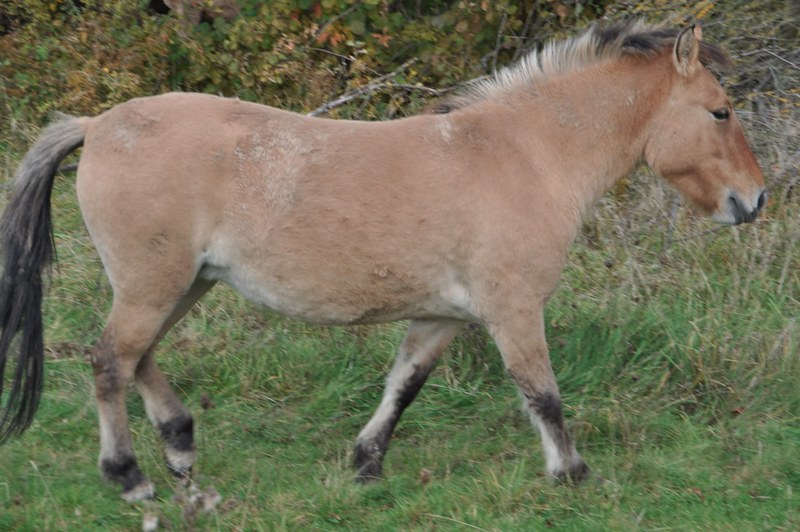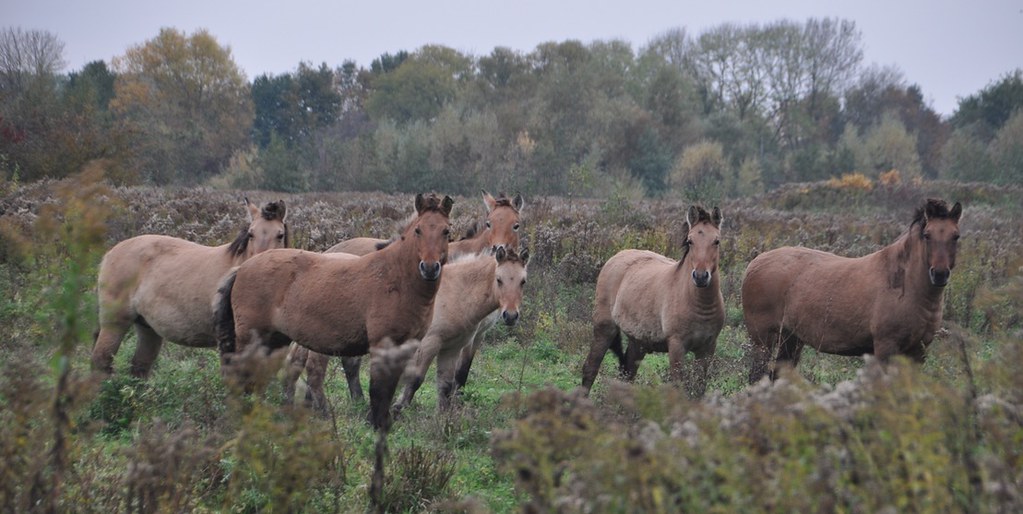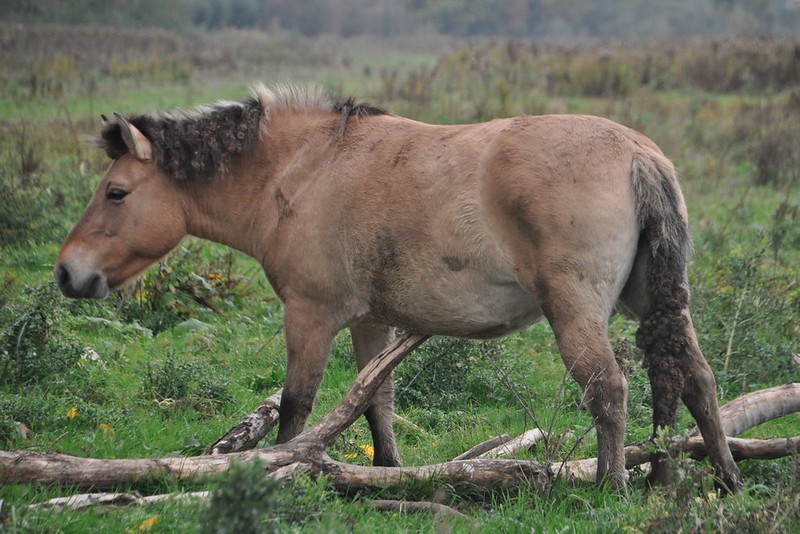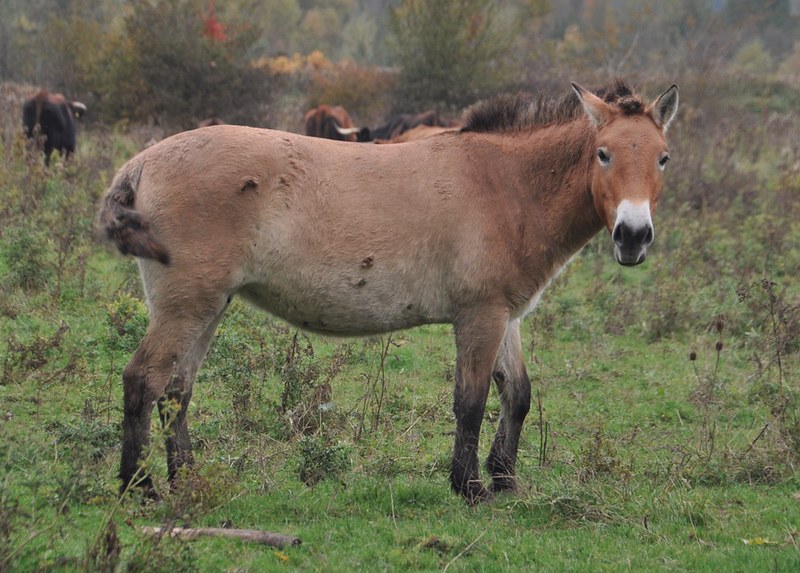The horses in the Lippeaue
With a major delay, I finally do my post on the horses in the Lippeaue reserve, Germany, today. I already covered them in my 2013 post, but on my trip in 2015 I gathered some more material, and the herds changed a bit as well.
As it is the case in so many reserves for landscape conservation, horses and cattle share the area because they complement each other in their grazing activity and both are native species. I don't know the total number of horses in the Lippeaue, perhaps about 40 individuals but that is only a guess.
The horse herd at Disselmersch consists of mostly pure Koniks, plus one Konik x Przewalski hybrid. The herd at Hellinghauser Mersch is, as far as I can see, completely mixed. They had a pure Konik stallion in the herd until at least 2013, but that one seems to be gone now. Now there are 50% Przewalski hybrids, 25% Przewalski and 75% Konik hybrids as much as a pure Przewalski mare. The 50-50 hybrids resemble a pure Przewalski rather close, except that the short mane is semi-erect and their head looks somehow more caballine. The colour of these Konik x Przewalski is phenotypically bay dun with countershading and a white muzzle (which seems, however, to be slightly reduced in these hybrids), which makes sense, since black (a) is recessive under bay (A+), which are the base colours for black dun and bay dun that we see in the Konik and Przewalski, respectively. The colour of the back-crosses with Koniks on the other hand is interesting to me. They should end up as either a//A+ or a//a with a 50% probability, so either the same colour as the first-generation hybrids or a pure Konik, yet at least a number of them has a colour that is somewhat more reddish and sooty than those of the first-generation hybrids. So there might be more than just one locus involved. Countershading and white muzzle are absent or strongly reduced in the Konik-backcrosses. The new dominant stallion seems to be one of those; the new generations will produce some further interesting animals because genetics will cause individuals that show mosaic traits of both horse types.
One might ask why crossing Konik and Przewalski's horses at all. As far as I understood, it was more of a coincidence that the ABU had the opportunity to use Konik and Przewalski's horses at the same time (I don't know if more than the one pure Przewalski mare were used). So it is kind of an experiment, and since the number of pure P. used is very low, I don't consider it a loss for the conservation of the subspecies.
It is an open question whether or not Przewalski's horses can or should be introduced into European natural areas - it seems that the common opinion in rewilding projects and organizations is that European domestic horses are to be preferred over the P. horse. There are several reasons in favour of using domestic horses instead of the P. horse for rewilding:
- The Przewalski's horse is not the western, but Asian subspecies, whereas domestic horses are descendants of the western wild horse subspecies
- The P. horse is an animal of the steppe and adapted to arid climate, shown also by its standing mane (historic references for the European wild horse describe a short but never a standing mane), whereas native European landraces are adapted to the local climate.
- Przewalski's horses and caballine horses separated between 120.000 and 240.000 years ago, the P. horse has one more pair of chromosomes and one more thoracic vertebrae (see Wikipedia) - so whether or not you regard both these types of equines separate species or not, they diverged quite some time ago and developed some evident differences. Mixing both types, or introducing one into the range of the other, would eradicate these results of evolution.
But there are also arguments in favour of using the Przewalski's horse for European rewilding:
- The P. horse is a wild animal, exhibiting a behaviour that is authentic for a wild horse, including a high intra- and interspecific aggression potential but also shyness towards humans in nature, whereas domestic horses often still remain tame after several generations, with their obtrusive behaviour causing troubles with workers and visitors (see Bunzel-Drüke et al. 2008).
- With the possible exception of the standing mane as much as the lack of the allele for a black base colour (a), the Przewalski's horse itself matches the morphology and looks of the western European wild horse quite well, as much as a number of primitive landraces do, including the "small" size, sturdy body, robust head et cetera.
- Although it seems that the P. is a different ecotype than European wild horses and European landraces are, they seemingly do well in the climate of this continent. In grazing projects like the Lippeaue or Döberitzer Heide they show no sign of discomfiture.
- As long as pure animals are used, wild European populations of the Przewalski's horse would help preserving the subspecies.
That's why I proposed that a mix of local or suitable landraces combined with influx from Przewalski's horses (by using crossbreeds, not pure individuals) would be a perspective for re-stocking Europe's natural area with authentic horse populations in a 2013 post. Nowadays I am not so convinced of that proposal anymore. As outlined above, the Przewalski's horse and caballine horses developed some recognizable genetic, ecologic (including geographic) and osteologic differences during about 200.000 years of separate evolution.
Nevertheless, Przewalski's horses have already been introduced in European natural areas such as Tschernobyl or the Puszta in Hortobagy (the latter is especially reminiscent of their natural habitat in Asia), where they do well.
The stock at the Lippeaue, however, is not supposed to become a large, self-sustaining population in a barely regulated area one day. Neither did someone propose that Konik x Przewalski is the one and only equine model for Europe's natural areas. Instead, they are the "grazing tools" of a conservation project for the Lippeaue reserve, and these experimental hybrids fulfill their job well.
Whether you are in favour of Przewalski influence in grazing projects or not, it seems that many Koniks might have P. introgression already due to intermixing with Heck horses, which are kind of diluted Koniks with Przewalski influence and also look that way. In the 1970s, Przewalski's horses were crossed in again at the Wildpark Hardehausen, so that about the half of their stock has a standing mane today (see Bunzel-Drüke et al. 2008). Heck horses and Koniks are often mixed indiscriminately with each other, so that they are hard to distinguish at least in German grazing projects today. For a Konik/Heck horse with a standing mane revealing its Przewalski influence, go here for example.
Bunzel-Drüke, Finck, Kämmer, Luick, Reisinger, Riecken, Riedl, Scharf & Zimball: „Wilde Weiden: Praxisleitfaden für Ganzjahresbeweidung in Naturschutz und Landschaftsentwicklung“ 2008.
As it is the case in so many reserves for landscape conservation, horses and cattle share the area because they complement each other in their grazing activity and both are native species. I don't know the total number of horses in the Lippeaue, perhaps about 40 individuals but that is only a guess.
The horse herd at Disselmersch consists of mostly pure Koniks, plus one Konik x Przewalski hybrid. The herd at Hellinghauser Mersch is, as far as I can see, completely mixed. They had a pure Konik stallion in the herd until at least 2013, but that one seems to be gone now. Now there are 50% Przewalski hybrids, 25% Przewalski and 75% Konik hybrids as much as a pure Przewalski mare. The 50-50 hybrids resemble a pure Przewalski rather close, except that the short mane is semi-erect and their head looks somehow more caballine. The colour of these Konik x Przewalski is phenotypically bay dun with countershading and a white muzzle (which seems, however, to be slightly reduced in these hybrids), which makes sense, since black (a) is recessive under bay (A+), which are the base colours for black dun and bay dun that we see in the Konik and Przewalski, respectively. The colour of the back-crosses with Koniks on the other hand is interesting to me. They should end up as either a//A+ or a//a with a 50% probability, so either the same colour as the first-generation hybrids or a pure Konik, yet at least a number of them has a colour that is somewhat more reddish and sooty than those of the first-generation hybrids. So there might be more than just one locus involved. Countershading and white muzzle are absent or strongly reduced in the Konik-backcrosses. The new dominant stallion seems to be one of those; the new generations will produce some further interesting animals because genetics will cause individuals that show mosaic traits of both horse types.
 |
| Mostly pure Koniks in the Disselmersch. |
 |
| Konik x Przewalski mare in the Disselmersch. |
 |
| Konik x Przewalski as much as 25% Przewalski 75% Konik crosses plus the pure Przewalski in the background. Hellinghauser Mersch. |
 |
| The pure Przewalski mare at the far left. |
 |
| A 25% Przewalski 75% Konik (?)stallion. Hellinghauser Mersch. |
 |
| Konik x Przewalski mare. |
 |
| The pure Przewalski mare, Hellinghauser Mersch. |
It is an open question whether or not Przewalski's horses can or should be introduced into European natural areas - it seems that the common opinion in rewilding projects and organizations is that European domestic horses are to be preferred over the P. horse. There are several reasons in favour of using domestic horses instead of the P. horse for rewilding:
- The Przewalski's horse is not the western, but Asian subspecies, whereas domestic horses are descendants of the western wild horse subspecies
- The P. horse is an animal of the steppe and adapted to arid climate, shown also by its standing mane (historic references for the European wild horse describe a short but never a standing mane), whereas native European landraces are adapted to the local climate.
- Przewalski's horses and caballine horses separated between 120.000 and 240.000 years ago, the P. horse has one more pair of chromosomes and one more thoracic vertebrae (see Wikipedia) - so whether or not you regard both these types of equines separate species or not, they diverged quite some time ago and developed some evident differences. Mixing both types, or introducing one into the range of the other, would eradicate these results of evolution.
But there are also arguments in favour of using the Przewalski's horse for European rewilding:
- The P. horse is a wild animal, exhibiting a behaviour that is authentic for a wild horse, including a high intra- and interspecific aggression potential but also shyness towards humans in nature, whereas domestic horses often still remain tame after several generations, with their obtrusive behaviour causing troubles with workers and visitors (see Bunzel-Drüke et al. 2008).
- With the possible exception of the standing mane as much as the lack of the allele for a black base colour (a), the Przewalski's horse itself matches the morphology and looks of the western European wild horse quite well, as much as a number of primitive landraces do, including the "small" size, sturdy body, robust head et cetera.
- Although it seems that the P. is a different ecotype than European wild horses and European landraces are, they seemingly do well in the climate of this continent. In grazing projects like the Lippeaue or Döberitzer Heide they show no sign of discomfiture.
- As long as pure animals are used, wild European populations of the Przewalski's horse would help preserving the subspecies.
That's why I proposed that a mix of local or suitable landraces combined with influx from Przewalski's horses (by using crossbreeds, not pure individuals) would be a perspective for re-stocking Europe's natural area with authentic horse populations in a 2013 post. Nowadays I am not so convinced of that proposal anymore. As outlined above, the Przewalski's horse and caballine horses developed some recognizable genetic, ecologic (including geographic) and osteologic differences during about 200.000 years of separate evolution.
Nevertheless, Przewalski's horses have already been introduced in European natural areas such as Tschernobyl or the Puszta in Hortobagy (the latter is especially reminiscent of their natural habitat in Asia), where they do well.
The stock at the Lippeaue, however, is not supposed to become a large, self-sustaining population in a barely regulated area one day. Neither did someone propose that Konik x Przewalski is the one and only equine model for Europe's natural areas. Instead, they are the "grazing tools" of a conservation project for the Lippeaue reserve, and these experimental hybrids fulfill their job well.
Whether you are in favour of Przewalski influence in grazing projects or not, it seems that many Koniks might have P. introgression already due to intermixing with Heck horses, which are kind of diluted Koniks with Przewalski influence and also look that way. In the 1970s, Przewalski's horses were crossed in again at the Wildpark Hardehausen, so that about the half of their stock has a standing mane today (see Bunzel-Drüke et al. 2008). Heck horses and Koniks are often mixed indiscriminately with each other, so that they are hard to distinguish at least in German grazing projects today. For a Konik/Heck horse with a standing mane revealing its Przewalski influence, go here for example.
Bunzel-Drüke, Finck, Kämmer, Luick, Reisinger, Riecken, Riedl, Scharf & Zimball: „Wilde Weiden: Praxisleitfaden für Ganzjahresbeweidung in Naturschutz und Landschaftsentwicklung“ 2008.


Comments
Post a Comment